 |
| Category: Badges |

|
|
|
|
|
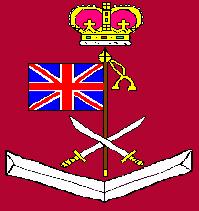 |
- The rank of colour sergeant was
introduced into the British Army in 1813 as the protector of the Ensign
and the Colour. Today we call those things "The
Colours"
There was/is no such rank in the
Australian Army except at the Royal Military College Duntroon, where
it was a rank within the Corps of Staff Cadets.
The escorts in a Colour Party
are often Staff Sergeants and for ceremonial occasions, when Colours
are on parade, they are referred to as
the colour sergeants.
|
The rank did exist in
Colonial Units. The most famous Australian ever to hold the rank was
General Sir John Monash who was Colour Sergeant of 4th Battalion
Victorian Rifles.
- The symbols of the badge are:
- The Crown to symbolise the
Nation
- The Union flag to symbolise
the colours
- Crossed swords to indicate
the role of the Colour Sergeant, namely the protection of the
Colours
- 3 chevrons below the crossed
swords to indicate that wearer had already attained the rank
of Sergeant and was, therefore, a respected soldier.
|
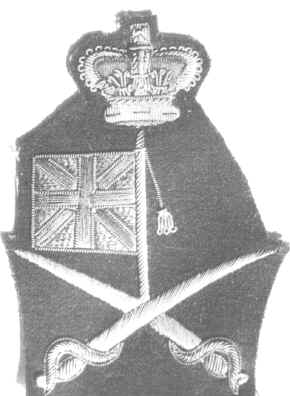
|
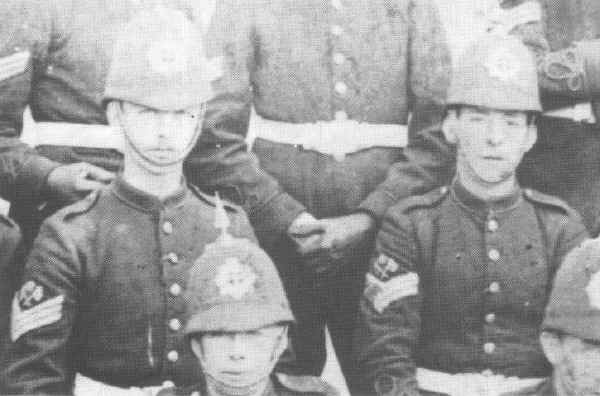 |
|
2 Colour Sergeants of
the Victorian Military Forces in the early 1890s. |
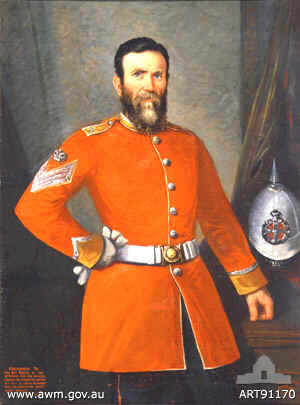 |
When
Colour Sergeant James Milton resigned from the Volunteers after 20 years
of service his fellow soldiers presented him with a life size portrait
of himself.
Sergeant Milton is resplendent in his
red uniform of the 4th Regiment, New South Wales Volunteer Infantry. |
| Pattern
1890-1898 unlined scarlet wool serge frock with single concealed coarse
linen pocket inside left front. Frock has five gilt 'QUEENSLAND' and VR
cypher buttons (made by Hobson & Sons, Lexington St, London), and is
stencilled in black inside right front 'B 7810'. Frock has 12.5 cm slit
at the bottom of each side seam, two waist hooks, blue stand collar and
pointed cuffs both edged, and decorated in the case of the cuffs, with
flat white worsted braid. Shoulder straps, which taper from 7.4cm at
seam to approx 2cm at neck, are secured with smaller gilt buttons of the
same pattern, edged with flat white worsted braid and have a separately
applied 'KENNEDY' which has been embroidered in a white semi-circle on
scarlet cloth. Each sleeve bears embroidered crossed flags insignia. |
 |
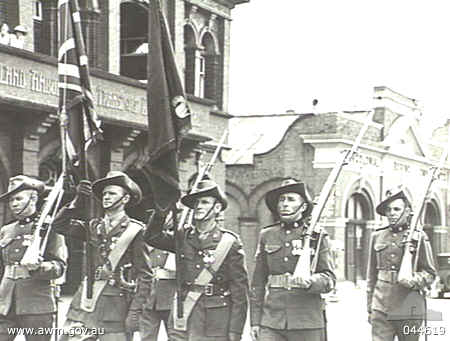 |
Members
of 9/49th Battalion AIF marching to St John's Cathedral for a laying-up
of colours ceremony. Identified left to right: CQMS Woodcroft; Captain C
J Stead with the King's Colour; Lieutenant T Cox DCM carrying the
regimental Colour; Sergeant Pratt; Warrant Officer Butler. Obscured in
the background (left is Sergeant Dalziel VC. (From the 49th Battalion
war diary AWM 52 Item 8/3/88). |
| Castlemaine,
Vic. c. 1894. Studio portrait of Sergeant Robert Gartside (born 1862).
Gartside enlisted in the 4th Victorian Rifles in 1885 and was promoted
to Colour Sergeant in 1894.
He was wounded in the South African
(Boer) War as a Lieutenant at Wolve Kuil on 14 Febuary 1901 while
serving with the 3rd Imperial Australian Bushmen. He retired as a Major
in 1903.
He re-enlisted in 1914, and served as
Second in Command of 8th Battalion as an acting Lieutenant
Colonel.
He was killed in action at Gallipoli
while leading a charge of the 7th Battalion near Tommies' Trench on 8
May 1915. He was posthumously awarded the Volunteer Decoration (VD).
(Donor: G.W. Gartside). |
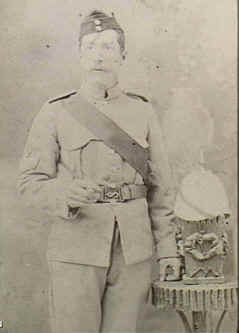 |
| Sometime after
the 1870s and probably in the late 1880s or early 1890s the crossed
swords disappeared from the Colour Sergeant's badge.
This roughly
equates with the end of the practice of taking the Colours into battle.
The last time that British Colours were last carried into battle was by
the 58th Foot (later the 2nd Battalion The Northampton Regiment) whose
Colours were carried at Laing's Nek in the 1st Boer War on 28 January
1881. |
 |
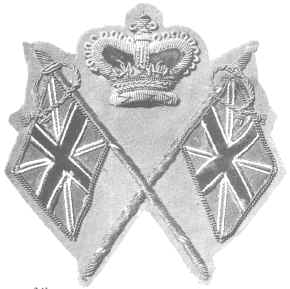 |
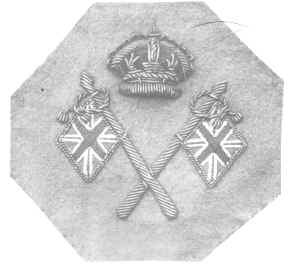
|
| Colour
Sergeant Victorian Military Forces c.1893 |
Colour Sergeant badge
c.1890 |
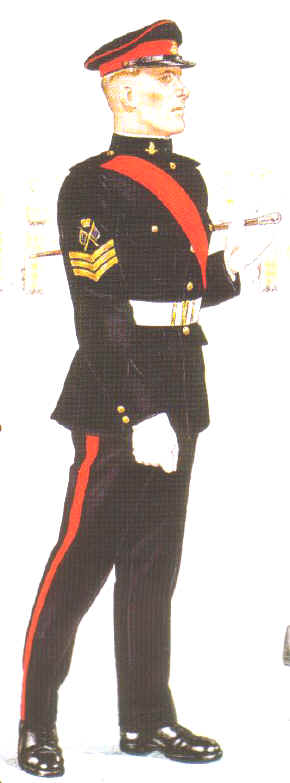
The rank of Colour
Sergeant has only been used in Australia (since Federation) by the Corps
of Staff Cadets at Royal Military College Duntroon. See above. Image
by Mike Chappell from the Osprey Publishing title The Australian Army at
War 1899-1975. ISBN 0-85045-418-2.
|
At the same time as the
crossed swords disappeared from the badge the second flag made an
appearance.
In Australia, at the Corps of Staff
Cadets the flags became stylised Australian flags.
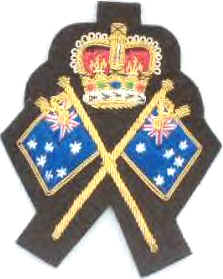
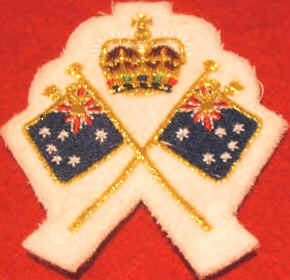

|
Badge of Rank
of the Colour Sergeant in the Coldstream Guards, 2003.
In recent times the crossed swords have been re-instated for
Colour Sergeants in Rifle Regiments in the UK. |
|
|

|
| Uganda,
East Africa. 1982. Group portrait of the Warrant Officer and
Non-commissioned Officer Wing of the Commonwealth Military Training Team
in Uganda. Left to right: standing: Sergeant (Sgt) Codner, Jamaica
Defence Force; Sgt McLeod, Kings Own Scottish Borderers; Sgt Caughey,
Royal Australian Regiment (RAR); Colour
Sergeant (CSgt) Rudge, Grenadier Guards;
Sgt Orth, RAR; CSgt Brayn,
Coldstream Guards; Staff Sergeant
(SSgt) Wazid, Guyana Defence Force; seated: Warrant Officer Class 2
(WO2) Fullerton, Jamaica Defence Force; WO2 Peter Stammers, RAR; Warrant
Officer Class 1 Chainsukh, Guyana Defence Force; Major Casey, RAR; WO2
Tombs, Grenadier Guards and SSgt McArthur, Guyana Defence Force. (Donor
P. Stammers) |
| Some
images and text from AWM. Some images from Australian Army Badges: Cloth
insignia of the Army in Australia 1860-1993 by J K Cossum ISBN 0 949530
14 X |
|